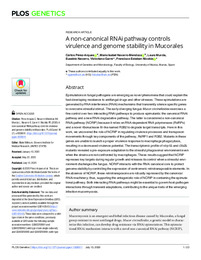Por favor, use este identificador para citar o enlazar este ítem:
https://hdl.handle.net/11000/35292
A non-canonical RNAi
pathway controls virulence and genome stability in Mucorales.
 Ver/Abrir: file.pdf
Ver/Abrir: file.pdf3,57 MB
Adobe PDF
Compartir:
Título :
A non-canonical RNAi
pathway controls virulence and genome stability in Mucorales. |
Autor :
Navarro Mendoza, María Isabel
Pérez-Arques, Carlos 
Murcia, Laura
Navarro, Eusebio 
Garre, Victoriano 
Esteban Nicolás, Francisco |
Editor :
Public Library of Science |
Departamento:
Departamentos de la UMH::Producción Vegetal y Microbiología |
Fecha de publicación:
2020-07 |
URI :
https://hdl.handle.net/11000/35292 |
Resumen :
Epimutations in fungal pathogens are emerging as novel phenomena that could explain the
fast-developing resistance to antifungal drugs and other stresses. These epimutations are
generated by RNA interference (RNAi) mechanisms that transiently silence specific genes
to overcome stressful stimuli. The early-diverging fungus Mucor circinelloides exercises a
fine control over two interacting RNAi pathways to produce epimutants: the canonical RNAi
pathway and a new RNAi degradative pathway. The latter is considered a non-canonical
RNAi pathway (NCRIP) because it relies on RNA-dependent RNA polymerases (RdRPs)
and a novel ribonuclease III-like named R3B2 to degrade target transcripts. Here in this
work, we uncovered the role of NCRIP in regulating virulence processes and transposon
movements through key components of the pathway, RdRP1 and R3B2. Mutants in these
genes are unable to launch a proper virulence response to macrophage phagocytosis,
resulting in a decreased virulence potential. The transcriptomic profile of rdrp1Δ and r3b2Δ
mutants revealed a pre-exposure adaptation to the stressful phagosomal environment even
when the strains are not confronted by macrophages. These results suggest that NCRIP
represses key targets during regular growth and releases its control when a stressful environment challenges the fungus. NCRIP interacts with the RNAi canonical core to protect
genome stability by controlling the expression of centromeric retrotransposable elements. In
the absence of NCRIP, these retrotransposons are robustly repressed by the canonical
RNAi machinery; thus, supporting the antagonistic role of NCRIP in containing the epimutational pathway. Both interacting RNAi pathways might be essential to govern host-pathogen
interactions through transient adaptations, contributing to the unique traits of the emerging
infection mucormycosis.
|
Tipo de documento :
info:eu-repo/semantics/article |
Derechos de acceso:
info:eu-repo/semantics/openAccess |
DOI :
https://doi.org/10.1371/journal.pgen.1008611 |
Publicado en:
PLoS Genetics 16 (7) |
Aparece en las colecciones:
Artículos Producción vegetal y microbiología
|
 La licencia se describe como: Atribución-NonComercial-NoDerivada 4.0 Internacional.
La licencia se describe como: Atribución-NonComercial-NoDerivada 4.0 Internacional.
 La licencia se describe como: Atribución-NonComercial-NoDerivada 4.0 Internacional.
La licencia se describe como: Atribución-NonComercial-NoDerivada 4.0 Internacional.
.png)
